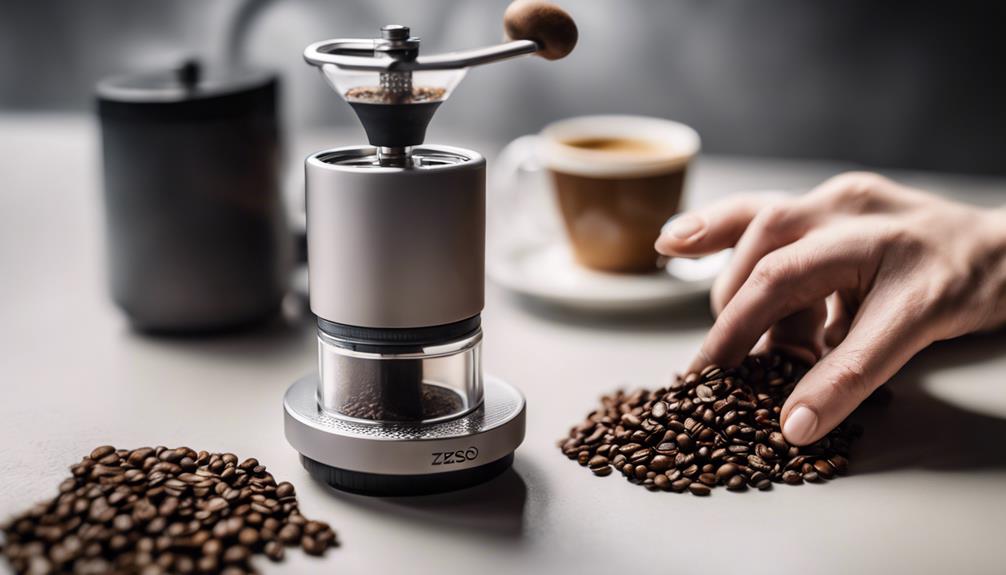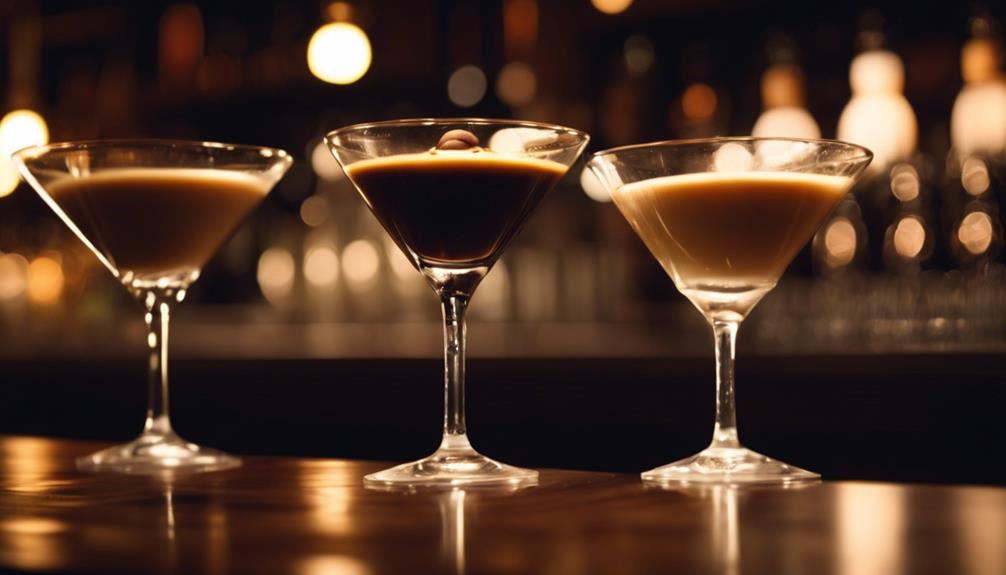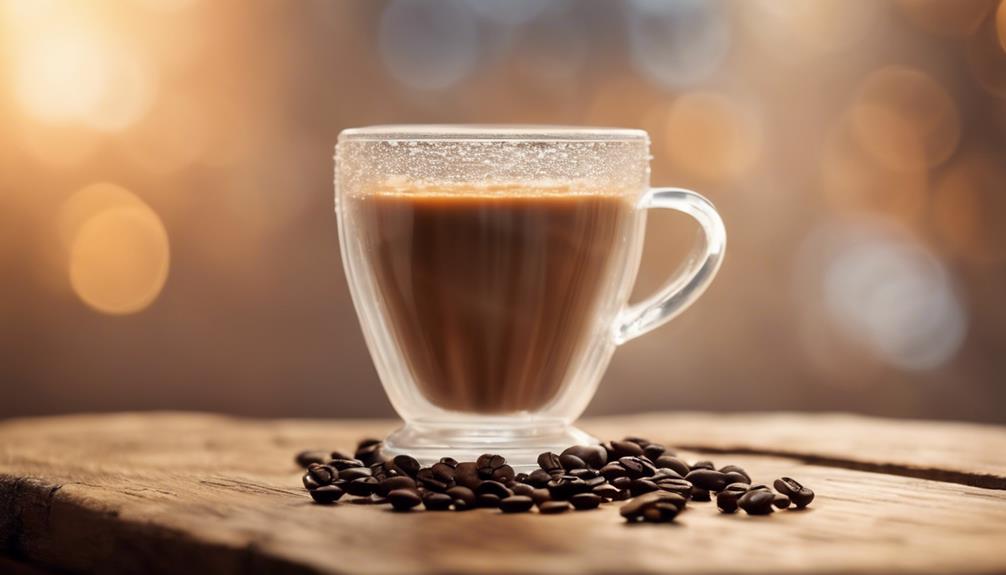When preparing espresso, grind your coffee beans for 10-15 seconds in a burr grinder. This will result in a fine to medium-fine consistency which is essential for extracting the best flavor. Consistent grinding is important for a balanced taste and proper extraction. Adjust the grind time to match your flavor preferences. Having a uniform grind size ensures even extraction and optimal flavor. Be cautious not to overheat the beans by grinding in short bursts. The grind size and time play key roles in achieving the perfect espresso shot. Your espresso will greatly improve by dialing in the grind just right.
Key Takeaways
- Burr grinders: Grind for 10-15 seconds for fine to medium-fine consistency.
- Blade grinders: Adjust grind time between 10-20 seconds, but expect some inconsistency.
- Consistency is key: Aim for 10-20 seconds for uniform espresso grind.
- Experiment for taste: Adjust grind time to impact flavor profiles.
- Test grind uniformity: Ensure even extraction with consistent particle size.
Burr Grinder Espresso Grind Time
For ideal espresso flavor, you should aim to grind your coffee beans in a burr grinder for around 10-15 seconds. This specific espresso grind time is vital in achieving a fine to medium-fine consistency, which is best for extracting a balanced espresso flavor.
Consistent grind size is key to ensuring that your espresso shot turns out just right. When using a burr grinder, the uniformity of the grind helps in the extraction process, bringing out the best flavors from the coffee beans.
It's essential to note that the grind time may need slight adjustments based on your espresso machine and the type of beans you're using. Over-grinding your coffee beans can lead to a bitter taste in your espresso, while under-grinding may result in a weak and under-extracted shot.
Therefore, sticking to the recommended 10-15 seconds of grinding time in a burr grinder can significantly impact the quality and taste of your espresso.
Blade Grinder Espresso Grind Time
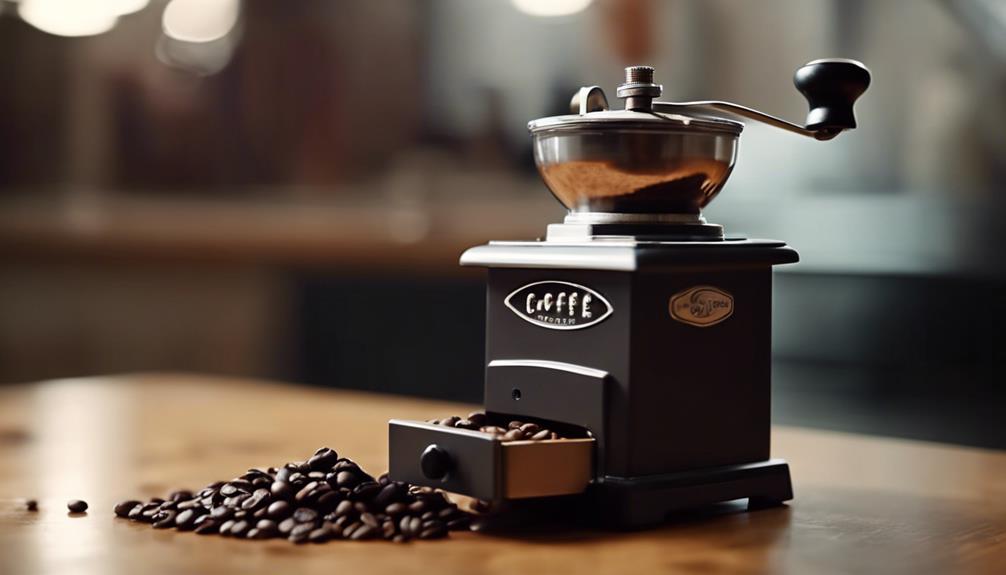
When using a blade grinder for espresso, it's important to acknowledge its limitations.
The consistency in grind achieved with a blade grinder may vary due to its chopping action.
Adjusting the grind time based on your taste preferences can help enhance the quality of your espresso extraction.
Blade Grinder Limitations
Consider adjusting the grind time between 10-20 seconds for espresso when using a blade grinder to avoid uneven grounds and overheating the beans. Blade grinders, while suitable for espresso, have limitations due to their lack of consistency in grind size.
Grinding beans for too long in a blade grinder can lead to uneven grounds, causing over-extraction or under-extraction during the brewing process. Overheating the beans is another risk when grinding for extended periods, which can alter the flavor profile of your espresso.
To mitigate these issues, it's essential to monitor the grinding process closely and adjust the grind time accordingly. While blade grinders can be a cost-effective option for home espresso brewing, their limitations highlight the importance of investing in a burr grinder for more precise and consistent grind times, ultimately enhancing the quality of your espresso shots.
Consistency in Grind
To achieve a consistent grind for your espresso using a blade grinder, focus on adjusting the grind time within the optimal range of 10 to 20 seconds. This timeframe helps in achieving an espresso grind that's finely textured with a uniform consistency.
Consistency in grind size is vital for ensuring that the water extracts the flavors evenly from the coffee grounds during the brewing process. By keeping the grind time within this specific range, you can enhance the extraction process, resulting in a well-balanced flavor profile in your espresso.
When using a blade grinder, it's essential to pay close attention to the grind time to avoid overheating the coffee beans. Short bursts of grinding can help prevent the beans from getting too hot and affecting the final flavor of your espresso.
Experimenting with different grind times allows you to fine-tune the extraction process and tailor the flavor of your espresso to your preferences. Achieving a consistent grind through precise grind time adjustments is key to producing a high-quality espresso with rich and flavorful results.
Adjusting for Taste
To adjust the taste of your espresso brew using a blade grinder, focus on experimenting with different grind times to achieve your desired flavor profile.
Here are some key points to keep in mind:
- Experimentation is Vital: Try varying the grind time in short bursts of 10-15 seconds to see how it impacts the flavor of your espresso. Shorter grind times result in a coarser grind, leading to a milder taste, while longer times may result in a finer grind with potential bitterness.
- Grinding Consistency Matters: Keep an eye on the grind texture to ensure uniformity. Adjust the grinding time based on the texture you observe, as it directly affects the quality of your espresso.
- Balancing Extraction Efficiency and Taste: Finding the sweet spot in grind time is important. Aim for a balance between extraction efficiency, which determines the strength of your espresso, and achieving your desired taste profile.
Experimentation will help you fine-tune this balance for a perfect cup.
Adjusting for Grind Consistency

Achieving consistent grind size is essential for perfecting your espresso shot, ensuring ideal extraction and flavor balance. Adjusting the grind time on your espresso machine can greatly impact the outcome of your coffee. By experimenting with different grind times, you can find the sweet spot that works best for your beans and machine. Here is a table to help you understand the effects of grind time on your espresso:
| Grind Time | Result |
|---|---|
| 10-12 seconds | Fine grind, potential for under-extraction |
| 12-15 seconds | Medium-fine grind, ideal for balanced extraction |
| 15+ seconds | Fine grind, potential for over-extraction |
Testing Ground Coffee Uniformity
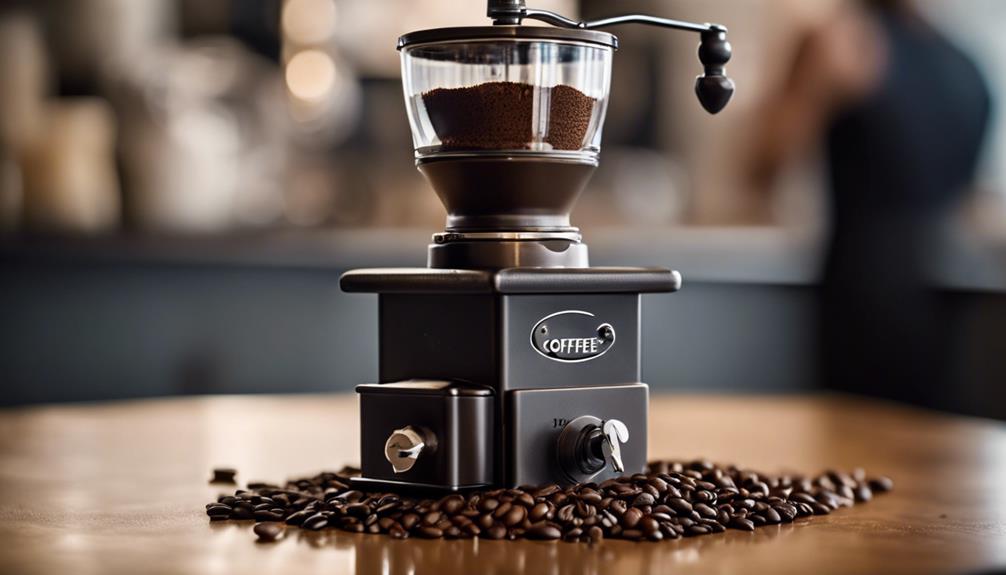
When testing ground coffee uniformity for espresso, make sure you spread the grounds evenly to evaluate particle size consistency.
Watch out for clumps or uneven distribution as they can affect the extraction process and ultimately the flavor of your espresso.
Achieving a uniform grind size is key to a balanced extraction and a delicious shot of espresso every time.
Uniformity in Grind Size
Examining the consistency of grind size throughout the batch is essential when testing ground coffee uniformity for espresso extraction. Achieving uniformity in grind size contributes greatly to the quality of your espresso shot. Here are three key points to keep in mind:
- Balanced Extraction: Consistent grind size ensures that each coffee particle extracts evenly during the brewing process. This balance is important for extracting the full range of flavors from the coffee beans.
- Flavor Impact: Variability in grind size can result in over-extracted or under-extracted flavors in your espresso shot. Uniformity in grind size helps prevent this and ensures a well-rounded, flavorful extraction.
- Burr Grinder Advantage: Using a burr grinder is recommended for maintaining uniformity in grind size. Burr grinders offer precise control over the grind size, leading to a more consistent extraction and a better-tasting espresso.
Impact on Espresso Flavor
To guarantee a well-rounded and flavorful espresso experience, testing the uniformity of ground coffee is essential in evaluating its impact on the overall taste profile.
The grind size plays a vital role in determining the flavor profile of your espresso. A consistent grind size ensures that the extraction time is balanced, leading to a well-extracted shot with ideal flavors.
If the grind size is too fine, the espresso may be over-extracted, resulting in a bitter taste. On the other hand, if the grind size is too coarse, the espresso might be under-extracted, producing a weak and lackluster flavor profile.
It's important to experiment with grind time and adjust accordingly to achieve the perfect balance in extraction.
Preventing Over Grinding Techniques
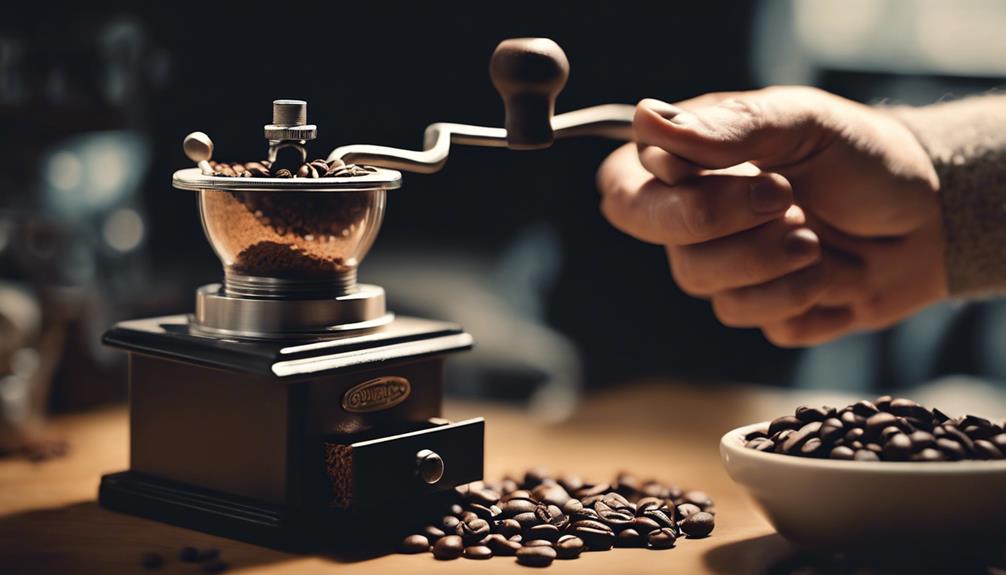
To prevent over grinding when preparing espresso, focus on adjusting the grinding time to guarantee ideal extraction and flavor balance. Here are three techniques to help you avoid over grinding and achieve the perfect espresso flavor:
- Monitor Grinding Time:
Aim to grind your coffee beans for around 10-15 seconds to prevent over-extraction, which can result in a bitter taste. Adjust the grinding time based on the type of beans you're using and the desired flavor intensity you want to achieve.
- Ensure Consistent Grind Size:
Consistency in grind size is key to a balanced extraction process. Varying grind sizes can lead to uneven extraction, affecting the overall flavor of your espresso. Experiment with different grind sizes and find what works best for your taste preferences.
- Taste and Adjust:
Don't be afraid to taste your espresso shots and make adjustments accordingly. If you notice bitterness, it might be a sign of over grinding. Use this feedback to fine-tune your grinding time for a more enjoyable espresso experience.
Ideal Grind Time for Espresso
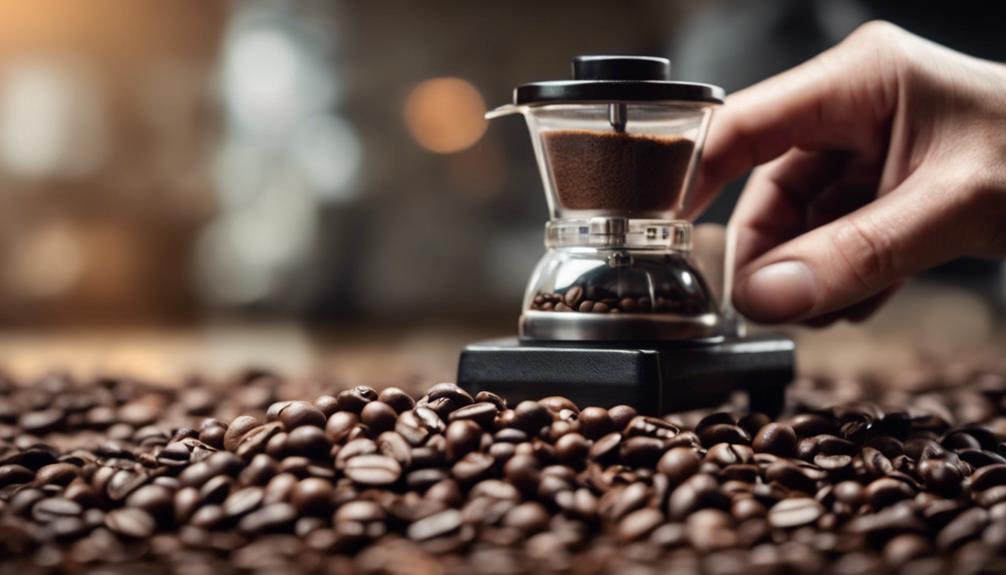
When grinding coffee beans for espresso, the optimal grind time plays a pivotal role in achieving the perfect flavor profile.
The grind size is essential for determining the extraction time, impacting the taste and quality of your espresso shot.
Experiment with different grind times to find the balance that suits your preference and equipment best.
Grind Size Importance
For achieving the perfect espresso extraction, understanding the importance of grind size and its ideal grind time is essential. When it comes to espresso, the grind size plays a vital role in determining the flavor and quality of your brew. Here's why the grind size is so important:
- Proper Extraction: The ideal grind size for espresso is fine to medium-fine, ensuring that the water extracts the flavors from the coffee beans effectively.
- Consistent Results: Consistent grind size is key to achieving a balanced espresso with the right flavor profile and aroma every time you brew.
- Avoiding Bitterness and Weak Espresso: Over-grinding can lead to bitterness, while under-grinding can result in a weak and underwhelming espresso. Finding the right balance in grind size and time is essential for a perfect cup of espresso that's neither too bitter nor too weak.
Extraction Time Impact
Achieving the perfect espresso extraction hinges on mastering the optimal grind time for the coffee beans. The grind time for espresso typically falls within the range of 10-15 seconds to achieve the necessary fine to medium-fine grind.
This pivotal step directly impacts the extraction process, playing a significant role in determining the flavor and strength of your espresso shot. Over-grinding can lead to a bitter taste, while under-grinding may result in a weak brew, highlighting the importance of getting the grind time just right.
Checking Intermittently While Grinding
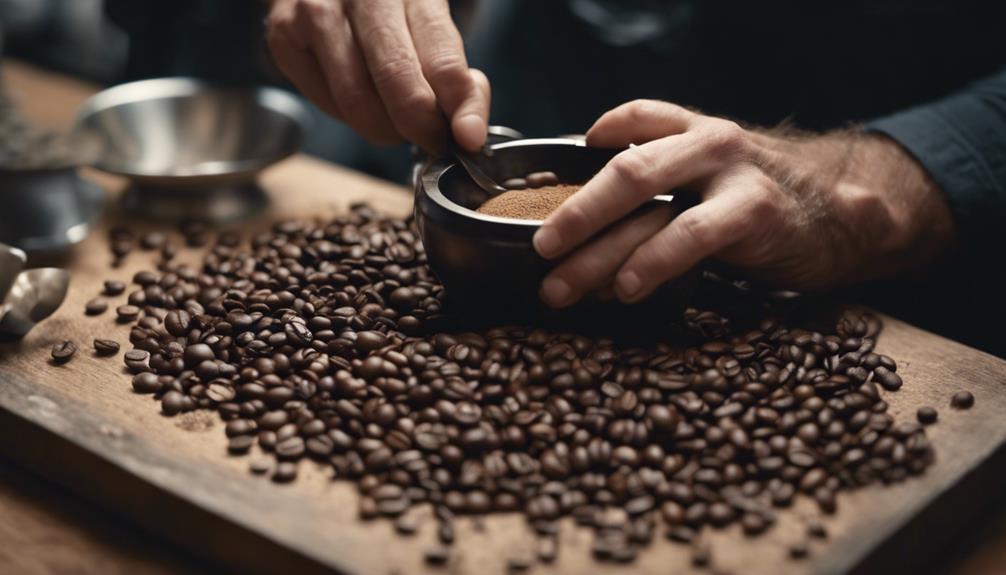
Periodically pause the grinding process to assess the consistency of the espresso grind. Checking intermittently helps you achieve the desired fineness for your espresso.
Here are some tips to help you navigate this important step:
- Adjust Grinding Time: Depending on your grinder and the type of beans used, the grinding time for espresso typically falls within the 10-15 second range. However, it's important to adjust this time based on your specific espresso machine and the flavor profile you aim to achieve.
- Prevent Over-extraction: By stopping intermittently to check the grind size, you can avoid over-extraction, which can lead to a bitter taste in your espresso. Maintaining the right grind consistency is key to achieving a balanced extraction.
- Experiment for Perfect Balance: Don't be afraid to experiment with different grind times. Finding the ideal balance of extraction and flavor for your espresso may require some trial and error, but the results are well worth it.
Achieving Perfect Espresso Extraction
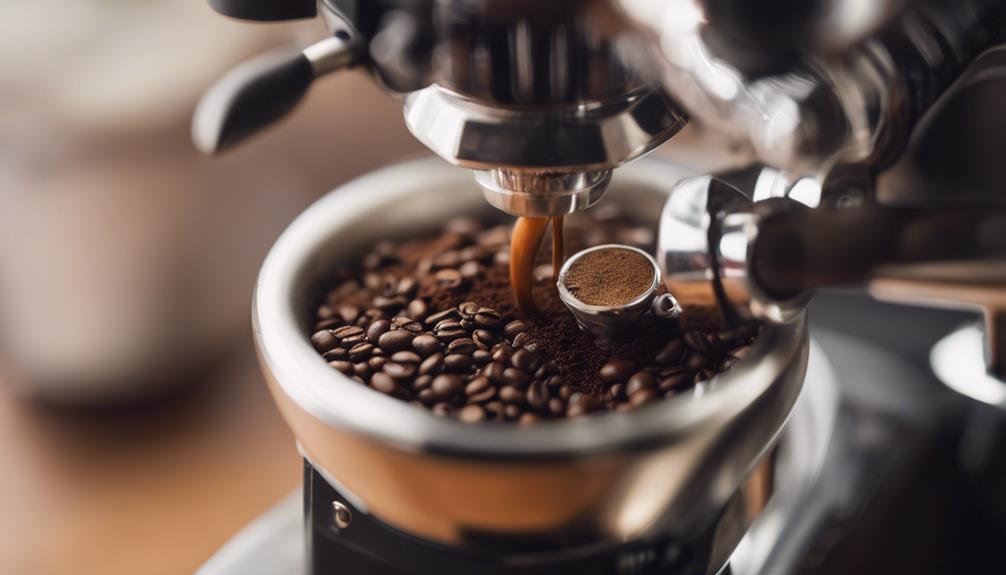
To achieve the perfect espresso extraction, make sure your grind size is fine to medium-fine, as this is essential for ideal flavor and strength in your shot. Consistency in the grind size is key to a balanced extraction process. The table below summarizes the importance of grind size in espresso extraction:
| Aspect | Importance |
|---|---|
| Grind Size | Vital for proper extraction; fine to medium-fine grind size guarantees ideal flavor and strength |
| Extraction | Dependent on grind size; impacts the extraction process, influencing the overall shot quality |
| Flavor | Affected by grind size; finer grinds often result in richer and more intense flavor profiles |
| Strength | Determined by the grind size; finer grinds usually yield stronger espresso shots |
Experimenting with different grind times can help you find the right balance to suit your taste preferences. Remember, a well-executed grind size plays a fundamental role in achieving that perfect cup of espresso.
Importance of Grind Time Adjustment
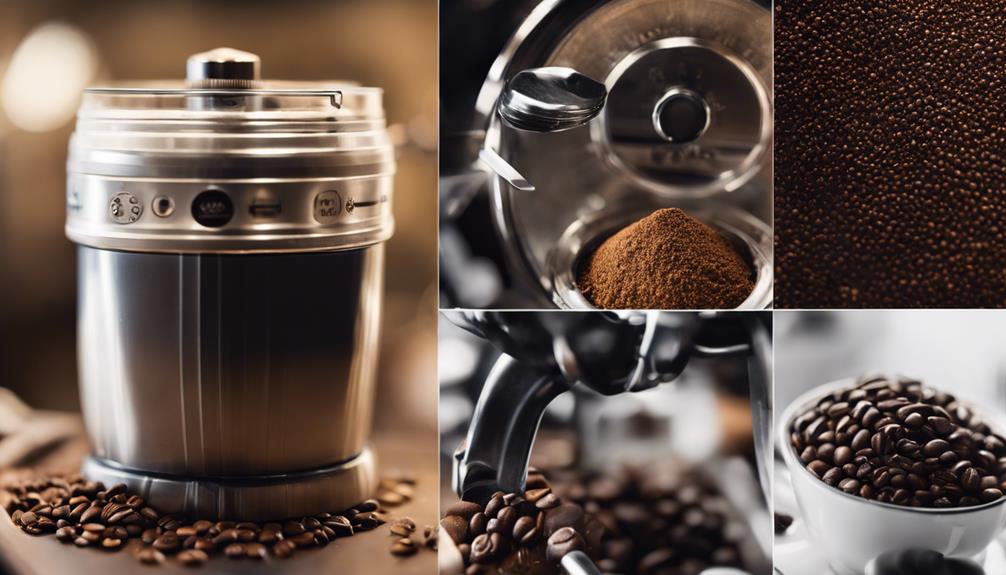
To optimize your espresso extraction process, consider the significance of adjusting grind time for achieving the ideal grind size and flavor balance in your shot. Here are some key points to keep in mind:
- Important Matters: Adjusting the grind time allows you to control the fineness of the coffee particles, affecting the rate of extraction during brewing. This precision is critical for extracting the flavors properly.
- Avoiding Bitterness or Weakness: Over-grinding or under-grinding due to incorrect grind times can result in unpleasant outcomes, such as a bitter or weak espresso. Adjusting the grind time helps you find that sweet spot for a well-balanced shot.
- Consistency is Key: Experimenting with different grind times helps you understand how it impacts flavor extraction. Consistent grind times not only maintain uniformity in grind size but also play an essential role in achieving a consistent flavor profile in your espresso.
Measuring for Optimal Espresso Grind
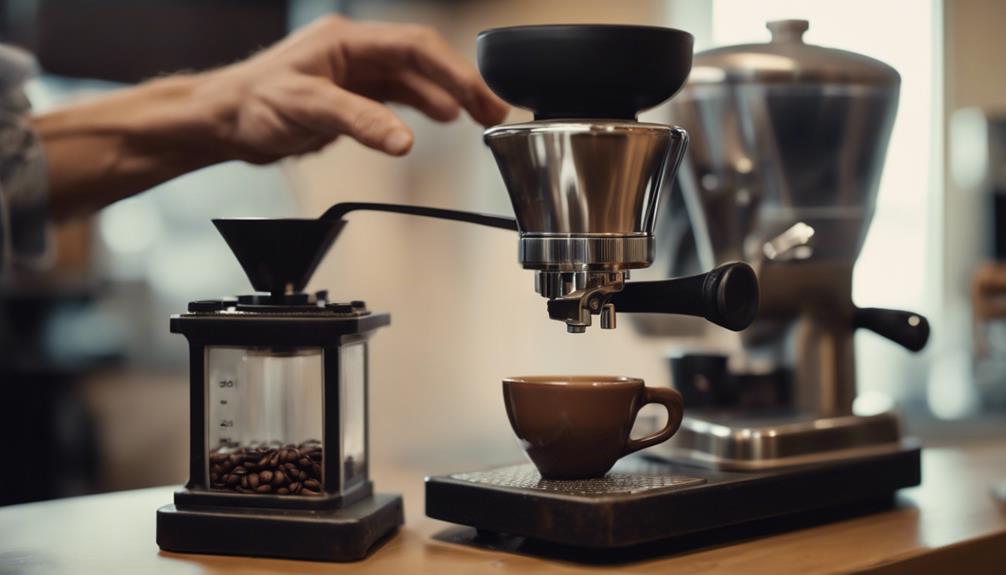
When aiming for the best espresso grind, focus on achieving a fine to medium-fine consistency to guarantee a proper extraction of flavors.
The grind time for espresso typically falls around 10-15 seconds, although this can vary depending on your grinder and the type of beans you're using.
Adjusting the grind size plays a pivotal role in determining the extraction time and the overall taste of your espresso.
Consistency in grind size is key to achieving a balanced espresso flavor, so don't be afraid to experiment with different settings to find the perfect one for your preferences.
Remember, using freshly ground beans just before brewing will yield the best results in terms of flavor and aroma.
Frequently Asked Questions
How Long Should I Grind Beans for Espresso?
When grinding beans for espresso, aim for about 10-15 seconds to reach the fine to medium-fine consistency required. This texture, akin to sugar, aids in proper extraction and flavor development.
Avoid over-grinding, as it may lead to bitterness in your shot. Tailor the grind time to suit your machine and taste preferences for the best results.
Can You Over Grind Espresso Beans?
Yes, you can definitely over grind espresso beans. Grinding them excessively can lead to bitterness by extracting too many flavors. Aim for 10-15 seconds of grinding to achieve a fine to medium-fine consistency.
Avoid that powdery mess by keeping an eye on the clock. Overheating the beans and ruining the flavor is a real risk if you grind for too long. Keep it short and sweet for a perfect espresso shot.
What Is the Best Grind Setting for Espresso?
For the best grind setting for espresso, aim for fine to medium-fine consistency to guarantee ideal extraction. This grind size allows water to pass through the coffee grounds at the right rate, extracting rich flavors without over-extraction.
Adjust your grinder to achieve this setting, typically taking 10-15 seconds to grind the beans. Experiment with different settings to find what suits your taste preferences best and results in a balanced and flavorful shot of espresso.
How to Grind Coffee Beans for Espresso With Blade Grinder?
To grind coffee beans for espresso with a blade grinder, pulse the grinder for about 10-15 seconds to achieve a fine to medium-fine consistency. Be cautious not to overheat the beans, as it can alter the espresso's flavor.
Adjust the grind time based on your desired fineness. Blade grinders are less consistent than burr grinders, so pay attention to the texture.
Achieve your perfect espresso grind with short bursts and careful monitoring.
Does Grinding Coffee Beans for Espresso Affect the Bitter Taste?
Grinding coffee beans for espresso can affect the bitter taste. When beans are ground too fine, over-extraction occurs, resulting in a bitter flavor. This happens because the water spends more time extracting compounds that cause bitterness. That’s why espresso tastes bitter if the beans are not ground properly.
Conclusion
In summary, the perfect grind time for espresso beans is essential for achieving the ideal extraction.
According to recent studies, the ideal grind time falls between 25-30 seconds for a consistent and uniform grind.
By adjusting the grind time based on the type of grinder used and regularly checking for uniformity, you can guarantee a delicious and well-balanced espresso every time.
Remember, precision in grind time is key to maximizing the full potential of your coffee beans.



